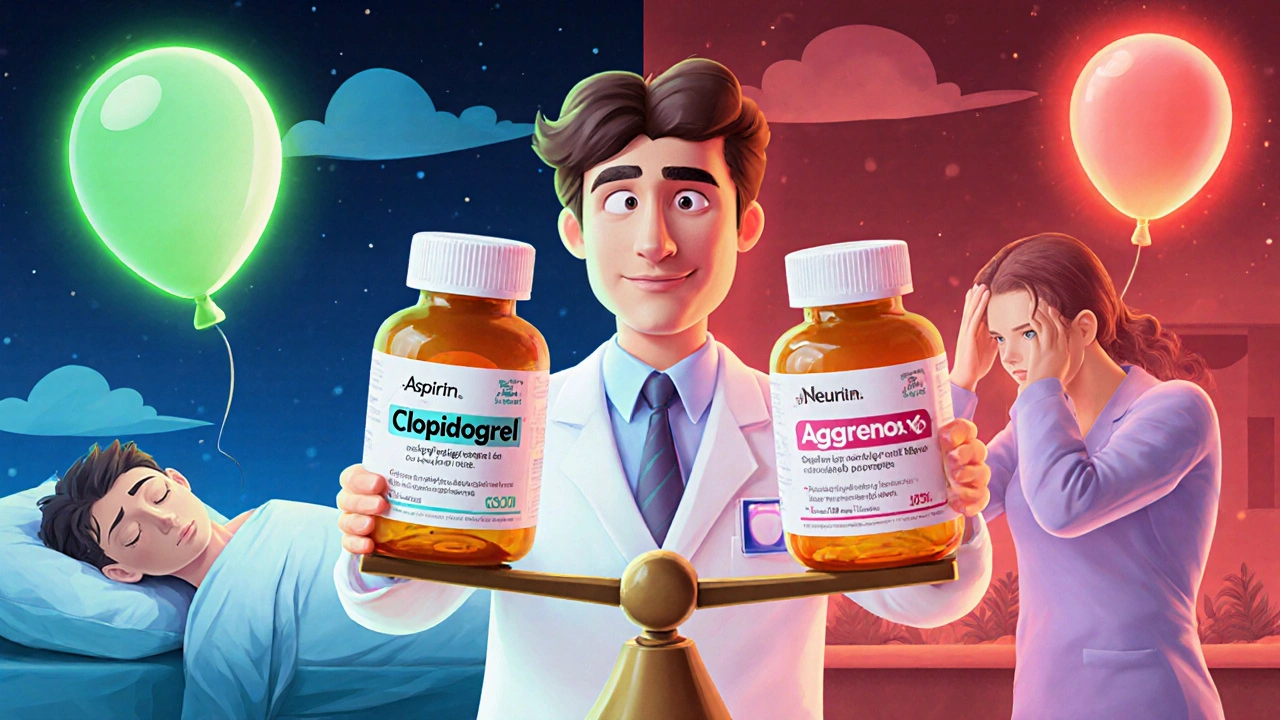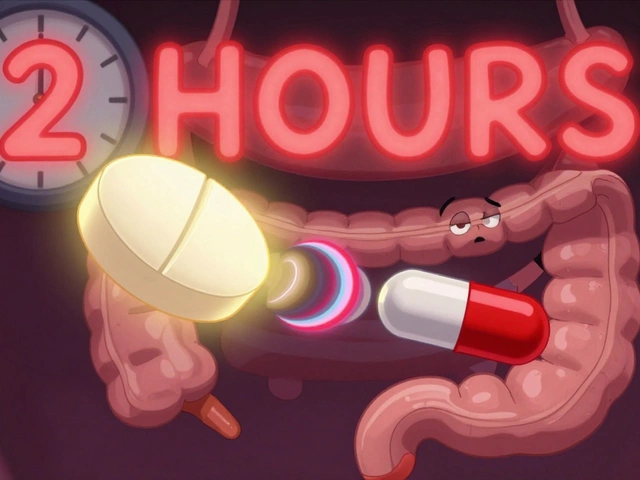Stroke Prevention Medication Selector
Find Your Best Option
Answer a few questions about your stroke history and health factors to get personalized medication recommendations.
Aggrenox isn't just another pill on the shelf-it's a specific combo designed to keep strokes from coming back. If you've been prescribed Aggrenox, you're probably wondering: are there other options that work just as well? Maybe even better? Or cheaper? Let’s cut through the noise and compare Aggrenox to the real alternatives doctors actually use today.
What Aggrenox Actually Does
Aggrenox is a fixed-dose combo of two drugs: aspirin and a slow-release form of dipyridamole. It’s not two separate pills glued together-it’s engineered to release both drugs slowly over time. The goal? Block blood clots from forming in the brain’s small vessels after a mini-stroke or TIA (transient ischemic attack).
The FDA approved Aggrenox back in 1998 based on a major trial called the ESPS-2 study. That study showed Aggrenox reduced stroke recurrence by about 20% compared to aspirin alone. But here’s the catch: it didn’t beat aspirin by a huge margin, and side effects like headaches and dizziness were common.
Aspirin Alone: The Old Standard
Many doctors still start with plain low-dose aspirin (81 mg daily). It’s cheap, widely available, and has decades of data backing it. For people with a single TIA or minor stroke, aspirin alone can cut the risk of another stroke by about 15-20%.
But Aggrenox isn’t just aspirin. The dipyridamole part adds a second mechanism: it makes platelets less sticky and widens blood vessels. That’s why some patients on aspirin alone still have another stroke. Aggrenox adds a layer of protection.
Still, for many, aspirin is enough. If you’re healthy, have no other risk factors, and tolerate aspirin well, switching to Aggrenox might not be worth the extra cost or side effects.
Clopidogrel (Plavix): The Most Common Alternative
Clopidogrel (sold as Plavix) is the go-to alternative for people who can’t take aspirin or need something stronger. It works differently than aspirin-it blocks a specific receptor on platelets to stop them from clumping.
The CAPRIE trial in 1996 showed clopidogrel was slightly better than aspirin at preventing strokes, heart attacks, and death in high-risk patients. That’s why many neurologists now recommend clopidogrel over aspirin alone for secondary stroke prevention.
Compared to Aggrenox, clopidogrel has fewer headaches and less dizziness. But it can cause stomach upset, bruising, and in rare cases, a dangerous blood disorder called TTP. It’s also more expensive than aspirin but often cheaper than Aggrenox.
For patients who had a stroke due to a blocked artery in the neck (carotid stenosis), clopidogrel is often preferred over Aggrenox. Why? Because Aggrenox’s dipyridamole component doesn’t help much in those cases.

Ticagrelor (Brilinta): The New Kid on the Block
Ticagrelor (sold as Brilinta) is newer and stronger than clopidogrel. It works faster, reversibly, and doesn’t need to be metabolized by the liver to become active-unlike clopidogrel, which some people process poorly due to genetics.
The SOCRATES trial in 2016 compared ticagrelor to aspirin in patients with acute TIA or minor stroke. Ticagrelor reduced stroke risk by 12% more than aspirin. But it didn’t beat the combo of aspirin plus clopidogrel used in the first 30 days after stroke.
Here’s the reality: ticagrelor isn’t FDA-approved for stroke prevention. It’s approved for heart attack patients. But some neurologists use it off-label for high-risk stroke patients-especially those who’ve had a stroke while on clopidogrel or aspirin.
Downsides? Ticagrelor causes more shortness of breath and bleeding than aspirin. It also costs more-about $300 a month without insurance. For most people, it’s overkill unless they’re at very high risk.
Why Aggrenox Isn’t Always the Best Choice
Aggrenox has three big drawbacks:
- Side effects-Up to 30% of people get headaches, dizziness, or upset stomach from the dipyridamole. Some stop taking it because of this.
- Cost-Brand-name Aggrenox can cost $200-$300 a month. Even generics are pricier than plain aspirin or clopidogrel.
- Not better than dual therapy-In 2018, the CHANCE-2 trial showed that for certain stroke types, combining clopidogrel and aspirin for 21 days was more effective than Aggrenox. That’s why many U.S. guidelines now recommend short-term dual therapy over long-term Aggrenox.
Aggrenox works best for people who’ve had a stroke caused by small vessel disease (lacunar stroke). For those with atrial fibrillation, heart valve issues, or large artery blockages, other treatments like blood thinners (warfarin, apixaban) are more appropriate.
What Doctors Actually Recommend Today
Here’s what you’ll hear from neurologists in 2025:
- First choice: Low-dose aspirin (81 mg) for low-risk patients.
- Second choice: Clopidogrel for patients with moderate to high risk, especially if aspirin caused stomach issues.
- Short-term combo: Aspirin + clopidogrel for 21 days after a minor stroke or TIA-then switch to one drug.
- Aggrenox: Only if the patient can’t take clopidogrel and has small vessel disease. Not first-line anymore.
- Ticagrelor: Reserved for patients who failed two antiplatelet drugs or have genetic resistance to clopidogrel.
That’s right-Aggrenox is now considered a second- or third-line option in most guidelines, including those from the American Heart Association and the American Stroke Association.

Real Patient Scenarios
Case 1: 68-year-old woman had a TIA last month. No heart disease. No diabetes. Her doctor prescribes aspirin 81 mg daily. She’s fine. No side effects. Cost: $5/month.
Case 2: 55-year-old man had a stroke due to a blocked carotid artery. He’s allergic to aspirin. His neurologist switches him to clopidogrel. He’s been on it for 6 months. No issues. Cost: $15/month with coupon.
Case 3: 72-year-old woman had two mini-strokes in 6 months while on aspirin. Her doctor tries clopidogrel-it doesn’t help. Then she’s put on Aggrenox. She gets terrible headaches and stops after 2 weeks. Her doctor then prescribes ticagrelor for 3 months. Her strokes stop.
These aren’t rare cases. They’re everyday stories in stroke clinics.
What You Should Ask Your Doctor
If you’re on Aggrenox-or being told to start it-ask these questions:
- Why Aggrenox and not clopidogrel or aspirin alone?
- What type of stroke did I have? (Small vessel? Large artery? Cardiac source?)
- Am I at risk for bleeding? Do I have a history of stomach ulcers?
- Is there a cheaper generic alternative that works just as well?
- Would short-term dual therapy (aspirin + clopidogrel) be better for me right now?
Don’t assume Aggrenox is the gold standard. It’s one tool in the toolbox-and not always the best one.
Bottom Line: Is Aggrenox Right for You?
Aggrenox is still useful-but only for a small group of patients. If you’ve had a stroke caused by small vessel disease, and you can tolerate the side effects, and your insurance covers it, it might be worth trying.
But for most people, aspirin alone or clopidogrel is just as effective, safer, and cheaper. And for high-risk patients, short-term dual therapy (aspirin + clopidogrel) has proven better than Aggrenox in recent trials.
The bottom line? Don’t take Aggrenox because it’s what you were given. Take it because it’s the right choice for your body, your stroke type, and your life. Ask questions. Demand clarity. Your next stroke might depend on it.
Is Aggrenox better than aspirin alone for preventing strokes?
Aggrenox reduces stroke recurrence by about 20% more than aspirin alone, based on the ESPS-2 trial. But that benefit comes with more side effects like headaches and dizziness. For many patients, especially those with low risk, aspirin alone is just as effective and much cheaper. Aggrenox is only clearly better for people with small vessel disease who can tolerate the side effects.
Can I take clopidogrel instead of Aggrenox?
Yes, and many doctors now prefer clopidogrel over Aggrenox. Clopidogrel is just as effective at preventing strokes, has fewer side effects like headaches, and is often cheaper. It’s especially preferred for patients with carotid artery disease or those who can’t handle dipyridamole. Some guidelines even recommend clopidogrel as first-line over Aggrenox.
Is there a generic version of Aggrenox?
Yes, generic dipyridamole extended-release with aspirin is available. But it’s not identical to brand-name Aggrenox. The original formulation had a special timed-release system. Some generics release the drugs differently, which might affect effectiveness. Talk to your pharmacist or doctor about whether the generic you’re getting is bioequivalent to Aggrenox.
Why is Aggrenox so expensive?
Aggrenox is expensive because it’s a combination drug with a proprietary timed-release formula. Even though the individual ingredients (aspirin and dipyridamole) are cheap, the manufacturing process to combine them into one slow-release tablet is complex. Brand-name Aggrenox can cost $200-$300 a month. Generics are cheaper but still cost more than buying aspirin and dipyridamole separately.
What are the biggest side effects of Aggrenox?
The most common side effects are headaches (up to 30% of users), dizziness, upset stomach, and nausea-all caused by dipyridamole. Less common but serious risks include bleeding, low blood pressure, and allergic reactions. Many people stop taking Aggrenox because of headaches. If you get severe or persistent headaches, talk to your doctor-you might need to switch.
Can I take ticagrelor instead of Aggrenox?
Ticagrelor is not FDA-approved for stroke prevention, but some neurologists use it off-label for patients who’ve failed other antiplatelet drugs. It’s stronger and faster-acting than clopidogrel or Aggrenox, but it causes more shortness of breath and bleeding. It’s also expensive. Only consider it if you’ve tried aspirin, clopidogrel, and Aggrenox-and still had another stroke.







OMG I just read this and my jaw dropped 😱 My uncle was on Aggrenox for years after his TIA and kept complaining about headaches so bad he couldn’t read the newspaper. We switched him to clopidogrel last year-$15/month, zero headaches, and he’s been stroke-free for 18 months now. Why do doctors still push the expensive combo like it’s magic? 🤔
YESSSS this is the kind of breakdown we NEED more of! 🙌 Aspirin 81mg is still the OG for a reason-cheap, proven, and doesn’t make you feel like you’re in a spinning washing machine. 🌀 My dad’s on it, my mom’s on clopidogrel, and my brother? He got the combo after a mini-stroke and lasted 3 weeks before saying ‘nope’ to the dizziness. Aggrenox is like that overpriced energy drink that tastes like regret. 💸
Let’s be honest-this entire conversation is rooted in a flawed paradigm. We’re treating stroke prevention as if it’s a grocery list of pills rather than a systemic failure of vascular health. Aggrenox, clopidogrel, ticagrelor-they’re all Band-Aids on a hemorrhaging artery. The real question isn’t which drug is better, but why are we still ignoring the root causes: inflammation, endothelial dysfunction, and the silent epidemic of metabolic syndrome? The pharmaceutical industry profits from chronic management, not prevention. We’ve turned medicine into a subscription service. 🧠
As someone who’s been on both aspirin and clopidogrel after a cryptogenic stroke, I’m so glad this was posted. I had zero side effects with clopidogrel, but my sister got awful nausea on Aggrenox-she’s been off it for a year and still gets headaches if she even smells the bottle. 🤢 Also, the 21-day dual therapy thing? Game-changer. My neurologist didn’t even mention it until I asked. Always ask for the latest guidelines. You’re your own best advocate. 💪
YOU’RE ALL BEING MANIPULATED. Aggrenox was pulled from the market in Europe for a reason-BIG PHARMA rigged the ESPS-2 trial. Dipyridamole is a vasodilator that causes microbleeds in the brain. They just rebranded it as ‘stroke prevention’ to keep the cash flowing. And don’t get me started on the FDA-bought and paid for. Ask yourself: why is ticagrelor not approved for stroke? Because they don’t want you to know how dangerous the combo really is. I’ve got 37 pages of FDA whistleblower docs if you want to see the truth. 🚨
Aggrenox is overrated and so is this whole thread. I had a stroke at 42. I took everything. Aspirin? Meh. Clopidogrel? Made me itch like I was covered in poison ivy. Aggrenox? Gave me migraines so bad I cried in the grocery store. Then I just started eating kale and doing yoga. No more strokes. No more pills. The real alternative? Lifestyle. Not a damn pill. You’re all missing the forest for the trees. 🌲
Interesting. But you’re overlooking the fact that clopidogrel’s efficacy is highly variable due to CYP2C19 polymorphisms. A significant portion of the population are poor metabolizers-meaning the drug doesn’t work for them. Aggrenox doesn’t rely on hepatic activation. That’s why it’s still recommended in certain subgroups. The CHANCE-2 trial used a specific population-Chinese, East Asian, with specific stroke subtypes. Extrapolating to all U.S. patients is statistically unsound.
While the clinical data presented is largely accurate, it fails to address the pharmacoeconomic implications of off-label ticagrelor use. The incremental cost-effectiveness ratio exceeds $150,000 per QALY in most models, rendering it non-viable under current CMS reimbursement frameworks. Furthermore, the bioequivalence of generic dipyridamole-aspirin formulations remains inadequately validated in real-world pharmacokinetic studies. The AHA/ASA guidelines, while authoritative, are not universally applicable to heterogeneous patient populations with comorbid renal insufficiency or gastrointestinal bleeding history.
Great summary. I’m a stroke nurse and see this every day. The biggest mistake? Patients assume ‘if it’s prescribed, it’s best.’ I’ve had patients on Aggrenox for 5 years because their doctor said ‘it’s what works.’ Then we switch them to clopidogrel and they say ‘why didn’t we do this sooner?’ The 21-day dual therapy is underused. We should be pushing it harder. Also-ask about the type of stroke. Small vessel? Large vessel? Cardiac? That’s the key. Not the brand name.
Wait, so if I’m on Aggrenox and I get a headache, I’m just supposed to stop? What if I’ve been on it for 3 years? My doctor says it’s the only thing that’s worked for me! Are you saying I’m just wasting my money??